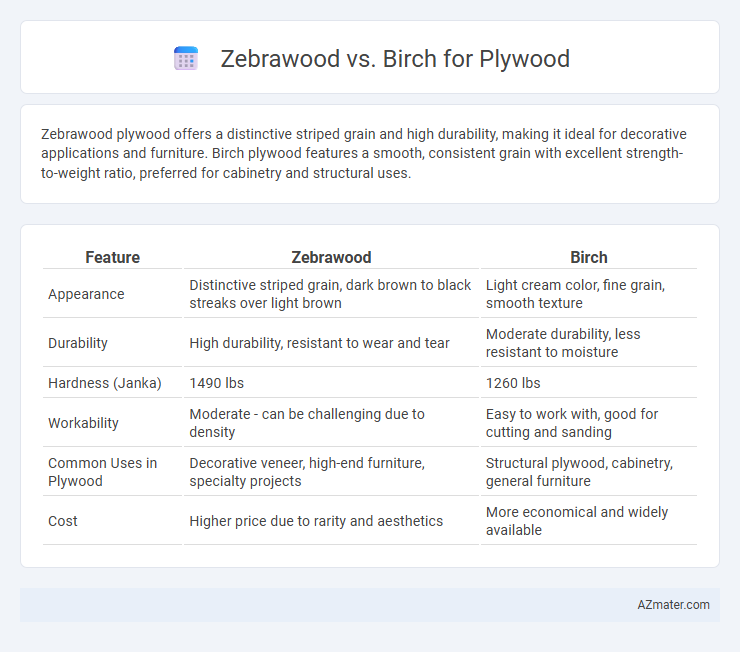Zebrawood plywood offers a distinctive striped grain and high durability, making it ideal for decorative applications and furniture. Birch plywood features a smooth, consistent grain with excellent strength-to-weight ratio, preferred for cabinetry and structural uses.
Table of Comparison
| Feature | Zebrawood | Birch |
|---|---|---|
| Appearance | Distinctive striped grain, dark brown to black streaks over light brown | Light cream color, fine grain, smooth texture |
| Durability | High durability, resistant to wear and tear | Moderate durability, less resistant to moisture |
| Hardness (Janka) | 1490 lbs | 1260 lbs |
| Workability | Moderate - can be challenging due to density | Easy to work with, good for cutting and sanding |
| Common Uses in Plywood | Decorative veneer, high-end furniture, specialty projects | Structural plywood, cabinetry, general furniture |
| Cost | Higher price due to rarity and aesthetics | More economical and widely available |
Introduction to Zebrawood and Birch Plywood
Zebrawood plywood, derived from the African Zebrawood tree, is prized for its striking dark stripes and exceptional durability, making it ideal for high-end furniture and decorative applications. Birch plywood, sourced from the fast-growing birch tree, is valued for its smooth, light-colored surface, strength, and versatility, commonly used in cabinetry and construction. Both types offer unique aesthetic and structural qualities, but Zebrawood excels in visual appeal while Birch provides cost-effective strength and ease of workability.
Origin and Botanical Background of Zebrawood vs Birch
Zebrawood, derived from the Microberlinia brazzavillensis tree native to Central Africa, is prized for its striking striped grain pattern and dense hardwood qualities. Birch plywood originates from the Betula genus, predominantly found in the temperate regions of North America, Europe, and Asia, known for its fine grain and consistent texture. The botanical differences reflect in their plywood applications, with Zebrawood offering unique aesthetics and durability, while Birch provides uniform strength and workability.
Appearance and Grain Patterns
Zebrawood plywood features bold, dark brown to black stripes on a golden-yellow background, creating a striking, exotic appearance ideal for high-end decorative applications. Birch plywood offers a uniform, light cream to pale yellow color with a fine, consistent grain pattern that provides a smooth, clean look suitable for cabinetry and furniture. The contrasting zebra-like grain of zebrawood adds visual texture and luxury, while birch's subtle grain supports versatile, minimalist designs.
Strength and Durability Comparison
Zebrawood plywood offers superior strength and durability due to its dense grain structure and natural resistance to wear and impact, making it ideal for heavy-duty applications. Birch plywood, while less dense, provides reliable strength with excellent flexibility and resistance to warping, often preferred for furniture and cabinetry requiring stability. The higher Janka hardness of Zebrawood compared to Birch contributes to its enhanced durability, though Birch plywood remains a cost-effective option with consistent performance in moderate use environments.
Workability and Machinability
Zebrawood plywood offers moderate workability due to its dense, interlocked grain, which can cause challenges during cutting and sanding but provides a stable finished surface. Birch plywood excels in machinability with its uniform grain and softer texture, allowing for smooth cuts, easy shaping, and minimal wear on tools. Both woods require proper blade maintenance, but birch generally ensures faster processing and cleaner edges in cabinetry and furniture applications.
Cost and Availability
Zebrawood plywood tends to be significantly more expensive than birch due to its exotic status and limited supply, often costing two to three times more per sheet. Birch plywood is widely available from numerous suppliers, providing a cost-effective and consistent option for both residential and commercial projects. The availability of birch plywood in standard sizes and grades ensures quicker procurement, while zebrawood plywood may require longer lead times due to its rarity.
Environmental Impact and Sustainability
Zebrawood plywood, sourced from African trees, often faces criticism for deforestation and habitat loss due to limited sustainable harvesting practices. Birch plywood, commonly harvested from North American and European forests with established sustainable forestry certifications like FSC, generally offers a lower environmental footprint. Choosing birch plywood supports responsible forest management and reduces ecological impact compared to zebrawood alternatives.
Common Uses in Furniture and Cabinetry
Zebrawood plywood is prized for its bold, distinctive grain patterns, making it ideal for decorative furniture accents and high-end cabinetry where aesthetics are paramount. Birch plywood, known for its fine grain and light color, is commonly used in structural applications like cabinet boxes and general furniture due to its durability and ease of finishing. Both woods offer strong stability, but Zebrawood's striking appearance excels in statement pieces, while Birch provides versatile, cost-effective solutions for varied cabinetry and furniture projects.
Maintenance and Care Tips
Zebrawood plywood requires regular sealing and oiling to maintain its distinctive grain pattern and prevent drying or cracking, while birch plywood benefits from occasional cleaning with a damp cloth and avoidance of excessive moisture to preserve its smooth surface. Both woods should be kept away from direct sunlight to minimize fading, but birch is more prone to water damage, making prompt drying of spills essential. Proper maintenance extends the lifespan of zebrawood and birch plywood, ensuring aesthetic appeal and structural integrity.
Which is Better? Choosing Between Zebrawood and Birch for Plywood
Zebrawood offers a striking, exotic grain pattern with high durability, making it ideal for decorative plywood applications where aesthetics and strength are essential. Birch plywood provides a smooth, uniform texture and is well-known for its strength-to-weight ratio, making it a versatile choice for structural and furniture projects. Choosing between Zebrawood and Birch plywood depends on whether visual impact or cost-efficiency and workability are prioritized in the project.

Infographic: Zebrawood vs Birch for Plywood
 azmater.com
azmater.com